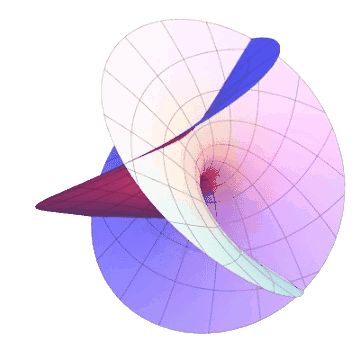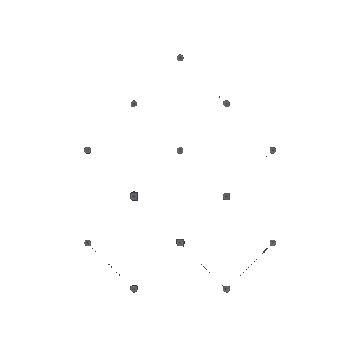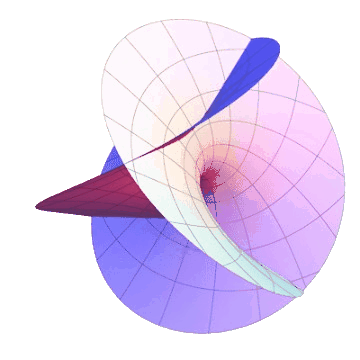

ALGEBRAIC GEOMETRY
The introduction of the digit 0 or the group concept was general nonsense too, and mathematics was more or less stagnating for thousands of years because nobody was around to take such childish steps…
A. Grothendieck
Algebraic geometry deals with curves or surfaces (or more abstract generalizations of these) which can be viewed both as geometric objects and as solutions of algebraic (specifically, polynomial) equations. Algebraic geometry sets out to answer these questions by applying the techniques of abstract algebra to the set of polynomials that define the curves (which are then called “algebraic varieties”). The mathematics involved is inevitably quite hard, although it is covered in degree-level courses. Other common questions in algebraic geometry concern points of special interest such as singularities, inflection points and points at infinity – we shall see these throughout the catalogue. More advanced questions in algebraic geometry concern relations between curves given by different equations and the topology of curves, and many other topics.
Categories and functors
We begin with an informal definition of categories and functors.
Categories.
A category consists of a collection of objects, and for each pair of objects, a set of morphisms (or arrows) between them. Morphisms are often informally called maps. The collection of objects of a category C is often denoted obj(C ), but we will usually denote the collection also by C . If A, B ∈ C , then the set of morphisms from A to B is denoted Mor(A, B). A morphism is often written f : A → B, and A is said to be the source of f, and B the target of f.
(Of course, Mor(A, B) is taken to be disjoint from Mor(A′, B′) unless A = A′ and B = B′.)
Morphisms compose as expected: there is a composition Mor(B,C)×Mor(A, B) → Mor(A,C), and if f ∈ Mor(A, B) and g ∈ Mor(B,C), then their composition is denoted g ◦ f. Composition is associative: if f ∈ Mor(A, B), g ∈ Mor(B,C), and h ∈ Mor(C,D), then h ◦ (g ◦ f) = (h ◦ g) ◦ f. For each object A ∈ C , there is always an identity morphism idA : A → A, such that when you (left- or right-)compose a morphism with the identity, you get the same morphism. More precisely, for any morphisms f : A → B and g : B → C, idB ◦f = f and g ◦ idB = g. (If you wish, you may check that “identity morphisms are unique”: there is only one morphism deserving the name idA.) This ends the definition of a category.
We have a notion of isomorphism between two objects of a category (a morphism f : A → B such that there exists some — necessarily unique — morphism g : B → A, where f ◦ g and g ◦ f are the identity on B and A respectively), and a notion of automorphism of an object (an isomorphism of the object with itself).
Functors.
A covariant functor F from a category A to a category B, denoted F : A → B, is the following data. It is a map of objects F : obj(A ) → obj(B), and for each A1, A2 ∈ A , and morphism m : A1 → A2, a morphism F(m) : F(A1) → F(A2) in B. We require that F preserves identity morphisms (for A ∈ A , F(idA) = idF(A)), and that F preserves composition (F(m2 ◦ m1) = F(m2) ◦ F(m1)). (You may wish to verify that covariant functors send isomorphisms to isomorphisms.) A trivial example is the identity functor id : A → A .
Definitions. If F : A → B and G : B → C are covariant functors, then we define a functor G ◦ F : A → C (the composition of G and F) in the obvious way. Composition of functors is associative in an evident sense.
A covariant functor F : A → B is faithful if for all A,A′ ∈ A , the map MorA (A,A′) → MorB(F(A), F(A′)) is injective, and full if it is surjective. A functor that is full and faithful is fully faithful. A subcategory i : A → B is a full subcategory if i is full. Thus a subcategory A ′ of A is full if and only if for all A, B ∈ obj(A ′), MorA ′ (A, B) = MorA (A, B). For example, the forgetful functor Veck → Sets is faithful, but not full; and if A is a ring, the category of finitely generated A-modules is a full subcategory of the category ModA of A-modules.
Definition. A contravariant functor is defined in the same way as a covariant functor, except the arrows switch directions: in the above language, F(A1 → A2) is now an arrow from F(A2) to F(A1). (Thus F(m2 ◦m1) = F(m1) ◦ F(m2), not F(m2) ◦ F(m1).)


Universal properties determine an object up to unique
isomorphism
Given some category that we come up with, we often will have ways of producing new objects from old. In good circumstances, such a definition can be made using the notion of a universal property. Informally, we wish that there were an object with some property. We first show that if it exists, then it is essentially unique, or more precisely, is unique up to unique isomorphism. Then we go about constructing an example of such an object to show existence. Explicit constructions are sometimes easier to work with than universal properties, but with a little practice, universal properties are useful in proving things quickly and slickly. Indeed, when learning the subject, people often find explicit constructions more appealing, and use them more often in proofs, but as they become more experienced, they find universal property arguments more elegant and insightful.
- Products were defined by a universal property. We have seen one important example of a universal property argument already in products. You should go back and verify that our discussion there gives a notion of product in any category, and shows that products, if they exist, are unique up to unique isomorphism.
- Initial, final, and zero objects. Here are some simple but useful concepts that will give you practice with universal property arguments. An object of a category C is an initial object if it has precisely one map to every object. It is a final object if it has precisely one map from every object. It is a zero object if it is both an initial object and a final object.
- Localization of rings and modules. Another important example of a definition by universal property is the notion of localization of a ring. We first review a constructive definition, and then reinterpret the notion in terms of universal property. A multiplicative subset S of a ring A is a subset closed under multiplication containing 1. We define a ring S−1A.


Schemes: The underlying set, and topological space
We will define a scheme to be the following data
• The set: the points of the scheme
• The topology: the open sets of the scheme
• The structure sheaf: the sheaf of “algebraic functions” (a sheaf of rings) on
the scheme.
A topological space with a sheaf of rings is called a ringed space.
For the set, in the key example of complex varieties (roughly, things cut out in Cn by polynomials), we will see that the points are the “traditional points” (n-tuples of complex numbers), plus some extra points that will be handy to have around. For the topology, we will require that “the subset where an algebraic function vanishes must be closed”, and require nothing else. For the sheaf of algebraic functions (the structure sheaf), we will expect that in the complex plane, (3×2+y2)/(2x+4xy+1) should be an algebraic function on the open set consisting of points where the denominator doesn’t vanish, and this will largely motivate our definition.
Differentiable manifolds.
As motivation, we return to our example of differentiable manifolds, reinterpreting them in this light. We will be quite informal in this discussion. Suppose X is a manifold. It is a topological space, and has a sheaf of differentiable functions OX. This gives X the structure of a ringed space. We have observed that evaluation at a point p ∈ X gives a surjective map from the stalk to R OX,p →R, so the kernel, the functions vanishing at p, is a maximal ideal mX,p .
We could define a differentiable real manifold as a topological space X with a sheaf of rings. We would require that there is a cover of X by open sets such that on each open set the ringed space is isomorphic to a ball around the origin in Rn (with the sheaf of differentiable functions on that ball). With this definition, the ball is the basic patch, and a general manifold is obtained by gluing these patches together. In the algebraic setting, the basic patch is the notion of an affine scheme, which we will discuss soon. (In the definition of manifold, there is an additional requirement that the topological space be Hausdorff, to avoid pathologies. Schemes are often required to be “separated” to avoid essentially the same pathologies.
Adapted from FOUNDATIONS OF ALGEBRAIC GEOMETRY No Copyright Infringement Intended



